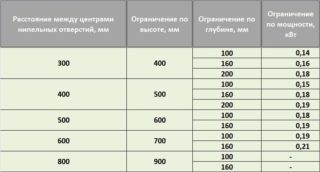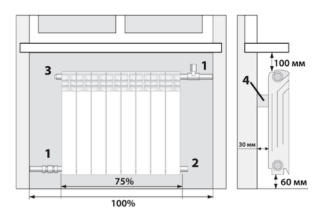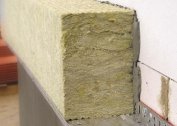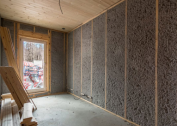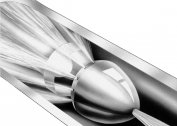Maintaining a comfortable room temperature directly depends on the size of the heating batteries and the center distance of the radiator. In case of violations during installation regarding the recommended distance between the radiator and the wall, the heating efficiency decreases markedly. To prevent possible problems, it is recommended that you study the features of installing batteries in advance and find out which parameters are considered acceptable for various types of radiators.
Description of the characteristics of the center distance of the radiator
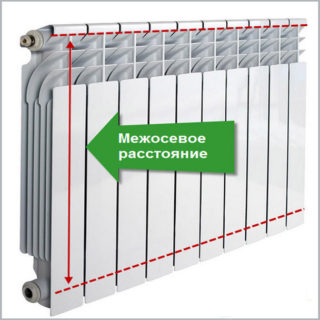 The interaxal or inter-nipple distance of the radiator is a value that indicates the gap between the central parts of the output and input collectors of the entire battery or each of its sections. It is indicated in the specification for the radiator, where its main characteristics are presented, and is indicated by the numbers of the model name of the device. This indicator is of particular importance in private homes where water is contained in the heating system in a natural way. If the gap is large, the fluid will not stagnate in such a radiator, due to which the efficiency will begin to increase.
The interaxal or inter-nipple distance of the radiator is a value that indicates the gap between the central parts of the output and input collectors of the entire battery or each of its sections. It is indicated in the specification for the radiator, where its main characteristics are presented, and is indicated by the numbers of the model name of the device. This indicator is of particular importance in private homes where water is contained in the heating system in a natural way. If the gap is large, the fluid will not stagnate in such a radiator, due to which the efficiency will begin to increase.
Values with a value of 300, 350 and 500 mm are considered standard, many modern manufacturers produce batteries of this type. There are models with other intervals, for example, in 200, 400 or 600 mm, in designer batteries this value reaches 2000 mm. For radiators with the same center spacing, the mounting height can be different and depends on the design features of the battery, the material from which it is made, as well as the design and brand. These values should not be confused, which is especially important when installing radiators in openings under windows or niches.
In houses of the Soviet or post-Soviet type, appliances with an interval of 500 mm were more often installed, for this reason options with this indicator are still more popular in Russia.
Dimensions of heating batteries
By type of material, radiators can be bimetallic, steel, aluminum or cast iron. The dimensions, general parameters and weight of the batteries directly depend on this, which must be taken into account when choosing the suitable option.
Bimetallic
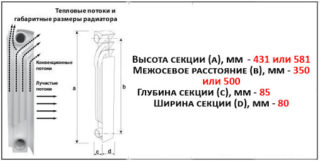 In appearance, the batteries from bimetal resemble aluminum devices, while their output and input collectors, as well as vertical heat-conducting channels, are made of stainless steel with an aluminum housing placed on top. Devices of this type are not subject to rust, they are resistant to water shocks, so they are often placed in apartments that are connected to a central heating system. The list of pluses includes a high level of strength, reliability, resistance to environmental influences, compatibility with all heating systems.
In appearance, the batteries from bimetal resemble aluminum devices, while their output and input collectors, as well as vertical heat-conducting channels, are made of stainless steel with an aluminum housing placed on top. Devices of this type are not subject to rust, they are resistant to water shocks, so they are often placed in apartments that are connected to a central heating system. The list of pluses includes a high level of strength, reliability, resistance to environmental influences, compatibility with all heating systems.
Dimensions of sections:
- Center distance: 200 mm, 350 mm, 500 mm.
- Height: 415 mm, 570 mm.
- Width: 80 mm.
- Depth: 75 mm, 85 mm, 90 mm, 100 mm.
Radiators have high heat transfer, do not require a large number of thermal carriers, the period of their operation reaches 20-25 years. They also have their drawbacks, for example, a creak that occurs due to the difference in the expansion coefficients of steel and aluminum. Vertical channels can become clogged, so their purity must be monitored separately, in addition, bimetal channels are more expensive than analogues from other materials.
Aluminum
Radiators of this type can be extrusion or cast, the second option is more popular, since such devices are highly durable and not susceptible to corrosion.Aluminum batteries provide optimal heat dissipation, they are easy to mount and transport due to their light weight, and they can heat up as quickly as possible.
The models are presented in various design options and represent the optimal combination of cost and heat efficiency. Of the minuses, the potential for damage due to water hammer is noted. Devices with a gap between the axes of 200 to 800 mm are presented on the market, the most popular are options in 350 and 500 mm.
Aluminum units can only be operated if there is no oxidized medium in the heat carrier, therefore they are not recommended to be installed in buildings with a central heating system.
Steel
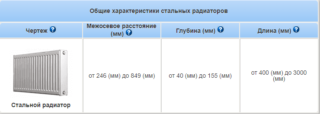 Devices made of steel, including with side connection, are tubular or panel. Panel-type radiators are a system of 1, 2 or 3 panels with fins from special U-shaped plates or without them. Each panel includes a pair of steel sheets with channels that are connected to each other by welding. The advantages of such radiators include increased heat transfer, convenient installation, resistance to damage, safety, reasonable cost and effective design.
Devices made of steel, including with side connection, are tubular or panel. Panel-type radiators are a system of 1, 2 or 3 panels with fins from special U-shaped plates or without them. Each panel includes a pair of steel sheets with channels that are connected to each other by welding. The advantages of such radiators include increased heat transfer, convenient installation, resistance to damage, safety, reasonable cost and effective design.
Tubular radiators consist of inlet and outlet manifolds, which are connected to each other using several rows of tubes with a thickness of at least 1.0-1.5 mm. All parts are joined by welding, which leaves no seams. The list of advantages of tubular radiators includes accelerated heating, resistance to aggressive environments and mechanical type loads, water hammer, the ability to choose the shape and color of the battery, safety and environmental friendliness, and no problems during operation.
The distance between the centers of the radiator fittings is 300 or 500 mm. The depth of the product section is from 40 to 115 mm. The thickness of the steel does not exceed 1.5 mm.
Panel devices may not withstand water hammer during system checks and often corrode. Among the disadvantages of tubular radiators, reduced heat transfer, the formation of leaks in the welding areas and the high cost are noted.
Cast iron
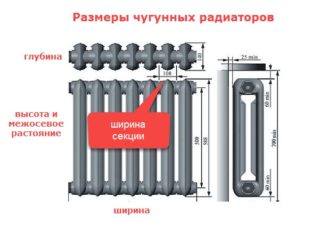 Cast iron batteries are still popular due to their good resistance to high temperatures, the absence of problems with corrosion and durability. In devices of this type, there are expanded channels that provide perfect circulation of the thermal carrier even during clogging. Cast-iron radiators give an accumulating effect and remain warm for a long time after stopping the flow of coolant.
Cast iron batteries are still popular due to their good resistance to high temperatures, the absence of problems with corrosion and durability. In devices of this type, there are expanded channels that provide perfect circulation of the thermal carrier even during clogging. Cast-iron radiators give an accumulating effect and remain warm for a long time after stopping the flow of coolant.
Such devices have their drawbacks, for example, large sizes compared to similar versions from other metals, as well as significant weight, because of which cast-iron radiators are equipped with supports. Due to the low thermal return of cast iron, batteries of this type slowly warm up the room. Many models have sections of complex shape, which is why caring for the device takes longer.
The height of the radiator section is from 400 to 900 mm, the depth is from 100 to 200 mm. The distance between the centers of the nipple holes is within 300-800 mm.
Advantages and disadvantages of radiators
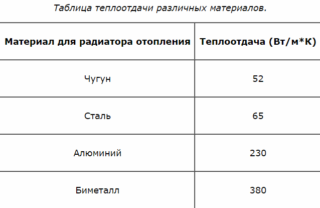 Modern domestic radiators are manufactured taking into account the peculiarities of Russian heating systems. Each device has its pros and cons, depending on its type. The most popular in Russia are cast-iron and aluminum batteries. Cast iron devices are selected because of their strength, ability to withstand operating pressure within 6–9 atm, and coolant temperature up to 130 degrees. Of their minuses, increased thermal inertia, instability to hydraulic shocks, installation difficulties due to the large weight of the batteries and not too aesthetic design are noted.
Modern domestic radiators are manufactured taking into account the peculiarities of Russian heating systems. Each device has its pros and cons, depending on its type. The most popular in Russia are cast-iron and aluminum batteries. Cast iron devices are selected because of their strength, ability to withstand operating pressure within 6–9 atm, and coolant temperature up to 130 degrees. Of their minuses, increased thermal inertia, instability to hydraulic shocks, installation difficulties due to the large weight of the batteries and not too aesthetic design are noted.
Aluminum appliances are in second place in popularity. Designed for pressure within 6-25 atm and temperature of the thermal carrier up to 130 degrees.Their advantages include high heat dissipation and good heating speed, economical energy consumption, the ability to adjust the room temperature, compact size and the absence of problems during installation, combined with a spectacular modern design. Of the minuses of such units, it is worth noting the low ability to convection, increased gas formation and a high probability of leakage.
Mounting Features
The installation process for any type of radiator consists of a series of standard steps. First of all, old batteries are dismantled, if any, and places for mounting fixtures are determined, on which the brackets are then fixed. At the second stage of installation, you need to prepare and hang the battery itself and install shutoff valves, then connect the pipes, observing the center distance in the radiators for heating. It is important to choose the right size for the heating batteries and install them correctly, regardless of size.
Radiators are placed strictly horizontally or with a slight slope, taking into account the direction of flow of the heat carrier. In the second case, when clogged, it will be easier to remove air jams.
You can connect the batteries to the mains from below, sideways or diagonally, a separate valve and a Mayevsky valve are installed on each device, which makes it possible to repair the radiator without having to completely turn off the entire system. The dimensions of the devices should be calculated in advance to determine their available power.
Manufacturer's choice
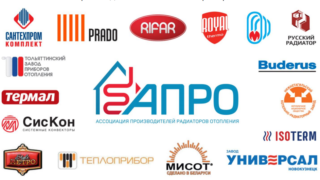 When choosing a brand, it should be borne in mind that many foreign radiators may not correspond to the peculiarities of Russian heating systems, so experts recommend giving preference to domestic batteries.
When choosing a brand, it should be borne in mind that many foreign radiators may not correspond to the peculiarities of Russian heating systems, so experts recommend giving preference to domestic batteries.
The most suitable options include models from Apriori, Elsotherm, Rifar, Faral and Konner. These are Russian brands that have proven themselves when working in various conditions.
From foreign manufacturers, experts advise giving preference to batteries from Kermi, IRSAP, Zehnder or Guratec. The devices of these brands are characterized by a high level of quality, made of durable materials and meet international standards.
